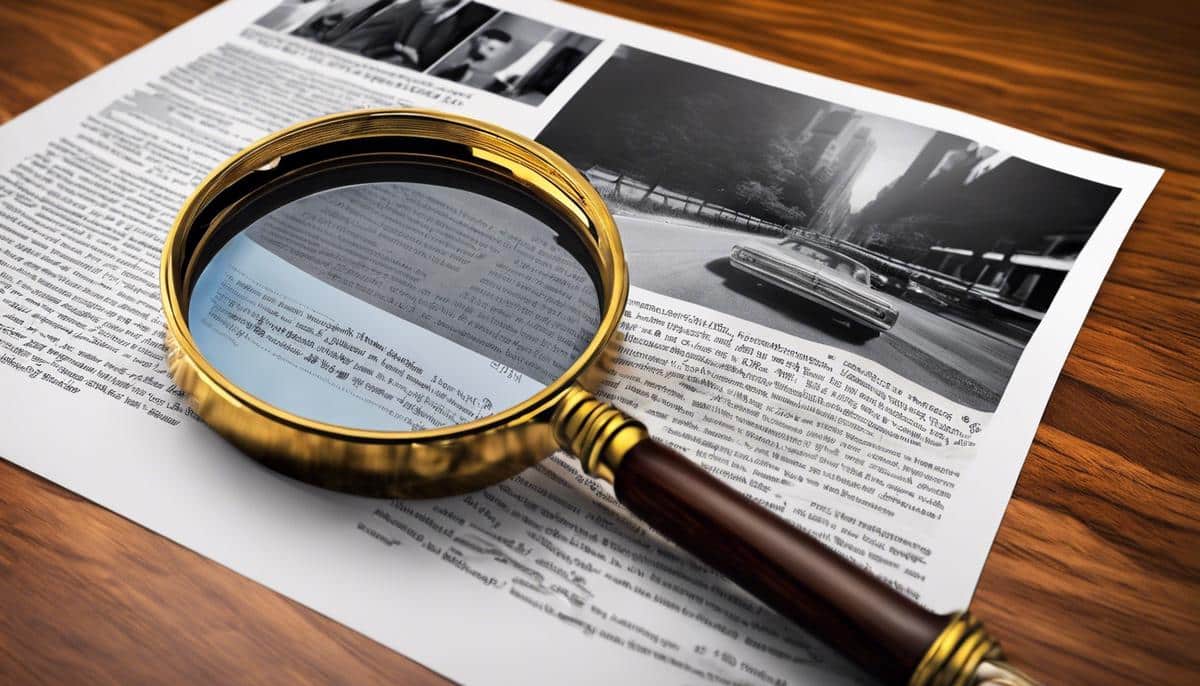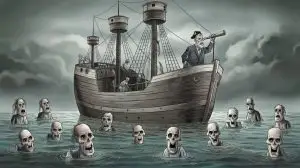Curious American Cold Cases. The shadowy world of unresolved mysteries, tucked quietly within the vast realm of criminal investigations, provides an impregnable fortress of questions that continue to perplex law enforcement agencies, seasoned forensic experts, and the general public. Years may turn into decades, but the haunting memories and riveting details of notorious unsolved American cold cases persist, passing down from one generation to another. The profound advancements in forensic science, the carefully crafted psychological methods employed in investigations, and the intricate weave of ethical and legal issues encountered are powerful tools to crack open these cold cases, yet they also unveil their distinct challenges.
Forensic Science Methods and Developments
Leveraging Advances in Forensic Science in Cold Case Investigations
The constant evolution of science perpetually unravels new facets of understanding, particularly in the realm of forensic science. This dynamic discipline has become a cornerstone in the sphere of criminal justice, playing an instrumental role in cold case investigations, which refer to criminal cases that have long remained unresolved. This article will delve into the intriguing world of how advancements in forensic science have influenced and shaped cold case investigations.
The birth of forensic science can be traced back to the late 19th century during Arthur Conan Doyle’s era, best known for his popular detective Sherlock Holmes. Yet, only in recent decades has forensic science’s influence on cold case investigations started to gain significant traction.
DNA analysis, for instance, has proven to be a game changer. With its advent in the 1980s, DNA technology revolutionized forensic science by providing an avenue to conclusively match biological evidence recovered from crime scene artifacts with potential perpetrators. Over the years, DNA analysis has seen substantial reform. The development of Short Tandem Repeat (STR) and touch DNA techniques have facilitated the extraction and analysis of DNA from hard-to-test samples like rootless hair or handled objects.
In the same vein, modern techniques such as Next-Generation Sequencing (NGS) and Phenotypic DNA Analysis (aka DNA Phenotyping) can generate a scientifically deduced, detailed physical profile (eye color, hair color, ancestry, etc.) directly from crime scene DNA, making suspect identification for cold case investigators more feasible.
While undoubtedly DNA analysis takes center stage, one should not discount other scientific breakthroughs such as digital forensics, geographic profiling or forensic entomology, each playing unique roles in solving cold cases. Digital forensics aids in the recovery and analysis of digital evidence found in electronic devices, providing an invaluable resource in today’s digital-driven society. The scientific method of geographic profiling applies statistical theories to crime scene locations, enabling investigators to predict the residence of a serial offender accurately. Forensic entomology, on the other hand, leverages the life cycles of insects for defining the post-mortem interval, providing essential clues in murder cases.
Facial reconstruction, yet another critical development in forensic science, provides a visual dimension to cold case investigations. By reconstructing the facial structure from skeletal remains, investigators have the opportunity to identify otherwise unrecognizable victims, leading potentially to significant case progression.
Notwithstanding these transformative advancements, the journey of forensic science in cold case investigations is an ongoing investigative odyssey. Developments in dispersed photon-sensors, for instance, are poised to transform the ways in which unsolved cases are approached, proving that the future of cold case investigations is both exciting and promising. In the grand objective of ensuring justice, it is assuring to know that science never sleeps, and every advancement takes us one step further in cracking the enigma of the cold case.

Notorious Unsolved American Cold Cases
Unsolved criminal cases, better known as “cold cases,” have etched indelible marks in America’s historical landscape, leaving legacies of mystery, intrigue, and unanswered questions. Due to their notorious nature and the enigmas they engender, these cases spur a continuous quest for the truth, often yielding seismic shifts in forensic science and enhancing our methodologies in investigation.
One striking instance is the Original Night Stalker case, also known as the East Area Rapist, a bewildering series of horrific crimes spanning the 1970s and 80s in California. Though its grim nature shocked the nation, the case proved instrumental in validating the importance of genetic genealogy in criminology. This technique involves deciphering a suspect’s family tree, harnessing public databases to search for potential relatives and, thereby, closing the gap to the suspect. In 2018, more than three decades since the last crime, the alleged perpetrator was ultimately identified using this very method, signifying a monumental breakthrough in cold case investigations.
Turning towards the eastern coast of the country, the infamous Original Boston Strangler case offers additional insights into the evolution of forensics. A string of chilling murders perplexed Boston authorities throughout the early 1960s. Attempts to solve this case marked one of the first documented instances of criminal offender profiling—an untested method back then, later refined by the FBI, that pioneered connecting psychological and behavioral patterns to physical evidence. Even though it provided an invaluable tool for law enforcement, the case remains unsolved due to the lack of conclusive scientific evidence and conflicting narratives.
The infamous Green River Killer case, which haunted Washington State in the 1980s and 90s, again underscored the persistent problems with evidence preservation. Despite the killer’s subsequent capture – after nearly two decades – it highlighted the crucial role that maintaining the integrity of the crime scene and evidence plays in eventually cracking such cold cases.
New methods of communication also paved the way for solving cold cases, as highlighted by the enigmatic Zodiac Killer case. Involving encrypted communication between the perpetrator and the media, it led to the development of enhanced cryptanalysis methods (the study of analyzing information systems to breach cryptographic security) and the conception of digital forensics. Despite these advancements, the Zodiac Killer’s identity remains an unsolved mystery, underlining the constant struggle between evolving forensics and perpetrators adapting to new technologies.
The D.B. Cooper hijacking case, an audacious mid-air theft unrolled in 1971, remains unparalleled in American crime history. From fingerprints to DNA, a plethora of forensic avenues have been pursued to unveil the true identity of D.B. Cooper, with each turn continually demonstrating the imperative for comprehensive integration of various forensics branches – including aerodynamics and aero forensics, a rapidly evolving branch of forensic study that deals with the recreation and study of transportation mishaps.
Each of these infamous cold cases, steeped in enduring mystery and intrigue, have in their unique ways, contributed to the evolution of forensic science, and still continue to offer invaluable lessons for modern cold case investigations. The ceaseless undertaking to resolve these cases symbolizes not just our quest for closure but our relentless pursuit of innovation and advancement in the realm of forensic science.

Psychological Aspects in Cold Case Investigations
Entering the realm of psychology, it becomes evident that this concept plays a paramount role in elucidating the enigma that enshrouds cold case investigations. Hereon, a concrete examination of how psychological aspects encroach upon the method and possibilities of solving these unfathomable mysteries would be discussed, thereby opening a new vista in the understanding of this intricate field.
A fundamental facet of psychology is cognitive bias, a systematic error in thinking that can potentially skew the interpretation of forensic evidence. Heuristics or mental shortcuts that are naturally utilised in human thought processes may lead investigators to misjudge evidence or jump to conclusions prematurely. For instance, confirmation bias, which involves favouring information that aligns with pre-existing beliefs, might divert the investigation’s trajectory. Traces of such biases have been propounded in cases like the Madrid Bombing in 2004, emphasising the necessity of promoting cognitive bias awareness to avert investigative missteps.
Furthermore, psychological profiling, which is an advanced and systematic process of discerning the behavioural, motivational and demographic aspects of offenders, can aid in narrowing down potential suspects. It allows the investigators to think in semblance with potential culprits, thereby devising probable investigative routes. This was significantly observed in the infamous ‘Unabomber’ case, where the insights extended by the FBI Behavioral Science Unit played a crucial role in apprehending Theodore Kaczynski.
The application of augmented reality (AR) and virtual reality (VR) have also emerged as powerful psychological tools in bridging the temporal gap in cold cases. AR/VR can recreate crime scenes, allowing investigators to explore them in intricate detail, which can evoke critical insights and new investigative avenues. Importantly, this provides the opportunity for the investigators to immerse into the original scene, supporting empathetic projection, and enabling investigators to better understand the victims and perpetrators.
With this, it mustn’t be overlooked that the psychological health of investigators indulged in cold cases warrants attention. The process of unravelling these investigations might unwittingly foster a sense of frustration, depressive feelings, or burnout due to the sheer complexity and grave nature of the cases. Psychosocial support mechanisms and mental health interventions for investigators are paramount in maintaining the effectiveness of these professionals.
Finally, the role of psychology in engaging with the public should not be underestimated. The engagement of the community, facilitated by psychological understanding, can be pivotal in refreshing complacent memories, retrieving essential eyewitness testimony, or prompting an admission, even years after the event. This was demonstrated in the recovery of Etan Patz’s murderer wherein a meticulous interrogation resulted in a confession after 33 years.
In conclusion, psychologically-informed methods undoubtedly contribute to the process and prospects of cold case investigations. Deep psychological understanding can challenge cognitive biases, aid in suspect profiling, leverage advancements in AR/VR technologies, support the mental health of investigators, and effectively engage with the public. As with any scientific endeavor, collaboration and integration of various disciplines, in this case, psychology with forensic science, may hold the key to unlock the secrets of the past that shape the present and future of criminology.

Legal-Ethical Challenges & Implications in Cold Case Investigations
Clearly, the landscape of cold case investigations is broad and varied, involving myriad facets of expert knowledge that range from the scientific to the behavioral. Yet alongside these points of required expertise are numerous legal and ethical challenges that investigators face in seeking to ensure that justice is served.
One significant challenge lies in the realm of privacy rights and expectations. As the scope of forensic technology broadens, the ethical implications surrounding informed consent and the use of personal genetic data come to the forefront. Genetic genealogy, for instance, as utilized in the identification of the Original Night Stalker, showcases the potential for familial DNA to unearth criminal activity. However, it simultaneously raises concerns about violations of privacy. While this method may expose possible suspects who otherwise might evade identification, it could also potentially encroach on the privacy of individuals unrelated to the crime.
This leads to another pertinent issue: the potential misuse of data and risk of false identification. With new technologies, comes the risk of premature or mistaken identification of suspects, putting innocent individuals at unnecessary risk. Such occurrences could lead to defamation, unwarranted distress, social stigmatization, or even wrongful convictions.
Another prominent ethical and legal issue revolves around the preservation and disclosure of evidence. The process of ensuring evidence is stored correctly and available for re-examination as techniques advance is crucial. However, failure to maintain or disclose evidence, knowingly or unknowingly, can lead to miscarriages of justice and potential legal ramifications. The Green River Killer case, which hinged on the successful preservation of crucial samples, underscores this necessity.
Moreover, the engagement of the public in cold case investigations, despite its potential benefits, also presents potential legal and ethical quandaries. While mass communication can uncover under-accessed testimonies or leads, it can also lead to public hysteria, false accusations, and undue influence on potential witnesses. The infamous Zodiac Killer case, where public communication became a critical part of the criminal’s strategy, provides a stark example of these risks.
Last but not least, the mental health of investigators himself/herself is a serious ethical consideration that requires attention. Investigators working on cold cases face unique psychological stressors, including the enormous pressure to solve cases that have long stumped their peers and the emotional toll of dealing with particularly heinous crimes. Ensuring the provision of proper mental health resources is not only ethically necessary but can also enhance the quality of investigation and mitigate risk of cognitive biases.
In conclusion, while rapid scientific advances are enabling unprecedented progress in solving cold cases, accompanying ethical and legal challenges necessitate judicious considerations. Strike a balance between fostering justice and respecting individual rights will remain a cornerstone of forensic investigations in the years to come. Through careful attention to these issues, the field of forensic science will continue to evolve in its pursuit of unmasking the truths hidden within cold cases.

Regardless of time lapse or hurdles in the path of justice, the silent stories wrapped within American cold cases deserve to be unveiled, with truth serving as the ultimate tribute to the victims and a beacon of hope for their families. With every development in forensic science, every evolution in psychological analyses, and every nuanced understanding of legal and ethical complexities, we inch closer towards unlocking these tales of untold mysteries. Cold cases, daunting as they might be, are a poignant reminder of the relentless pursuit of justice, strengthening our societal resolve to decipher the obscurest of crimes.
Steve is the creative force behind My Unique Tales, a blog dedicated to sharing captivating stories that explore the human experience in all its complexity. With a passion for writing and a talent for crafting engaging narratives, Steve's blog is a treasure trove of imaginative tales that transport readers to other worlds and challenge them to see things from new perspectives. From epic adventures to intimate character studies, Steve's stories are always thought-provoking and emotionally resonant. With a growing following of readers who appreciate his unique voice and creative vision, Steve is quickly becoming a rising star in the world of online storytelling.






